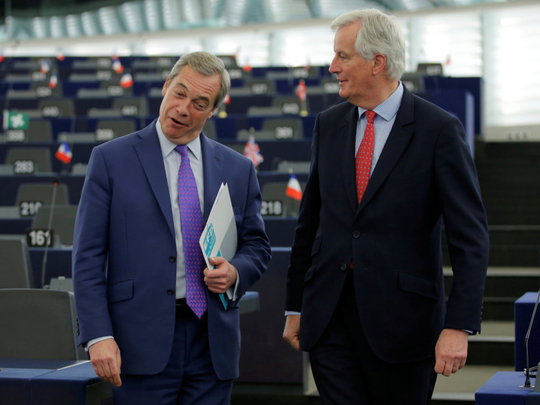
UK Finance Minister Philip Hammond refused on Friday to rule out the nation remaining in the EU Customs Union, post-Brexit, putting himself at odds with Prime Minister Theresa May. His intervention, which underlines that fundamental elements of the government’s Brexit vision still remain in flux, comes as the third, historic chapter begins this month in the long-running saga around the UK’s exit from the EU.
This third phase of Brexit will see formal negotiations beginning soon on a potential transition period for when the United Kingdom is scheduled to leave the EU in 2019. Then this Spring London will also try to secure a final framework deal for its EU exit that will kick-in in the 2020s after any transitional period that is agreed.
The first phase of Brexit came after the June 2016 referendum when there were sometimes heated intra-UK debates about leaving the EU which were replayed in last June’s general election too. The end of this first chapter came with the triggering of Article 50 by London in March 2017 which started UK-EU discussions around divorce issues like the UK’s exit bill for leaving the Brussels-based club, and post-Brexit rights for citizens.
And on December 8, a preliminary EU-UK deal was agreed on these divorce issues, heralding the upcoming third phase of Brexit. As 2018 dawns, it is already clear that this third stage will see the toughest phase of negotiations yet.
The forthcoming stage of talks encompasses not just the nature and length of Brexit transitional arrangements; and the parameters of the newly defined UK-EU relationship, including a new trade deal. But they will also involve issues not fully resolved in earlier UK-EU divorce discussions, including the future of the Irish border.
This is a massive task, not least as the EU Commission’s Chief Brexit Negotiator Michel Barnier has said that a final framework deal should be reached by October 2018. This timetable is especially short given that any fundamental decisions from the EU side may not be possible until after a new German government is formed following last September’s elections.
The limited timeframe offered by Article 50 is exactly why the UK Government wants a transition period to help smooth Brexit. This will help give time to adjust to new political and regulatory frameworks, although some leading Brexiteers, including former United Kingdom Independence Party leader Nigel Farage have slammed this option as pointless “backsliding”.
While there is a growing sense amongst some stakeholders that a transition deal is now inevitable, it is not. Barnier has said such a period would be “useful” but has to be time limited to from when the United Kingdom leaves the EU in 2019 until December 31 2020, the end date of the EU’s current budget.
However, Barnier has also said it is important first to know more in 2018 about the UK’s final negotiating positions. Specifically, “what the intentions of a request from the United Kingdom are, what they would like and what they are prepared to accept with the new [long-term] partnership” once the United Kingdom leaves the EU.
Remarkably, the UK Cabinet only had its first discussion in December about what it wishes the nature of the final deal with Brussels to be. No details of this meeting have yet emerged so the most authoritative roadmap remains the two key speeches May gave in January and September 2017 in London and Florence respectively.
In January 2017, May asserted that she does not want to keep “bits of the EU”, including the Customs Union, but would like a “bold, ambitious free trade agreement” with “the freest possible trade on goods and services”; a new customs agreement that would allow for “tariff-free trade with Europe and cross border trade that is frictionless as possible”, while leaving the Common Commercial Policy and no longer been tied to the Common Commercial Tariff. At the same time, she aims to take back full control of immigration policy, and move toward ending the European Court of Justice’s jurisdiction in the United Kingdom.
Even with goodwill from both sides, it is very unclear whether these collective negotiating demands can be realised from the EU in the timeframe of Article 50 given its own robust negotiating positions. This is especially so given May’s weakened political standing after June’s UK general election where she lost her parliamentary majority.
Indeed, it remains possible that her government could fall in 2018. So with a significant amount now beyond her power, even more rests on whether the remaining 27 EU states will offer outlines of such a deal on attractive enough terms to her to accept.
European Commission President Donald Tusk has said that May is becoming “more realistic” about the trade-offs that will be necessary in the final negotiations. Much will now depend on the flexibility of both sides, and here it is interesting to note, for instance, that the UK’s Secretary of State for Brexit David Davis has said that the government would consider making a continuing EU financial contribution to “get the best possible access for goods and services to the European market”.
Yet, even with the first phase deal reached on December 8, the talks could still breakdown in 2018. Indeed, Lord Kerr of Kinlochard, the author of the EU’s Article 50 clause, has previously asserted that there is at least a one in three chance that no final overall agreement will emerge; and ultimately also that there is only a 50% likelihood of an orderly Brexit.
The stakes in play in securing a final deal, and transition, are therefore huge and historic not just for the United Kingdom but also the EU. Delivering a smooth departure will need clear, coherent strategy and thinking so all parties can move toward a new constructive partnership that can hopefully bring benefits for both at a time of significant global geopolitical turbulence.
Andrew Hammond is an Associate at LSE IDEAS at the London School of Economics









